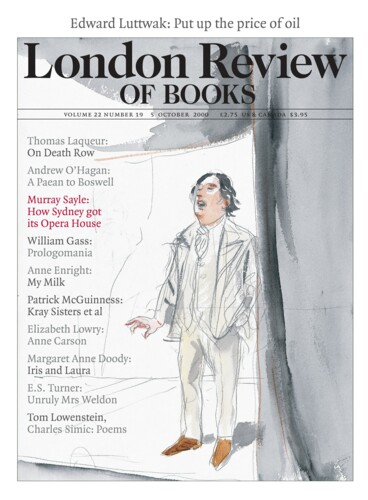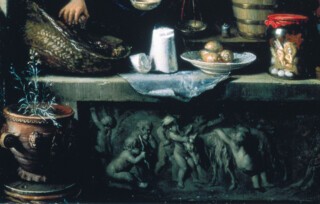Adetail from The Grocery Shop by Gerrit Dou (1613-75), now in the Queen’s Collection – bought by George IV for 1000 guineas in 1817. Dou’s reputation (and prices) were then still high. He gave tremendous value. He attended closely to the play of light as it came through a window or was thrown out by a candle. He rendered the textures of wood, metal, fabric and fur meticulously. No wonder he died a wealthy man. Then, in the latter half of the 19th century, his reputation suffered a near complete eclipse. Other ways of handling paint and seeing the world became dominant. Vermeer and Hals were rediscovered. Dou’s skills were despised. His paintings were ‘monuments of an irrelevant virtue’ which showed how ‘patience may be misused’ (Walter Armstrong, Director of the National Gallery of Ireland in 1904). He was no longer avidly collected: there was not a single panel by Dou in the exhibition held in the Metropolitan Museum of Art in 1909 of 150 Dutch paintings from the collections of wealthy Americans (Widener, Frick, Morgan, Altman and Marquand). The Dutch art historian Willem Martin, in the introduction to a monograph of 1901, almost apologised for giving time to the work. Like Joshua Reynolds, he said, he turned from Dou ‘with admiration on the lips but indifference in the heart’.
This is the story told by Arthur Wheelock in his essay on Dou’s reputation in the catalogue of the exhibition of his work which can be seen at Dulwich Picture Gallery until 19 November. Wheelock goes on to describe the reassessment of Dou which took place in the later decades of the 20th century, when art historians, armed with an interest in iconography and deeper knowledge of 17th-century art theory, searched for deeper meanings both in the content of his pictures and in his eye-deceiving skills.
The exhibition suggests that we reconsider Dou; it offers a fine selection from his work to encourage us. They are small pictures – the biggest, The Quack, is 44 inches high; most of the others are less than half that. You must look at them close up to appreciate the detail – you are clearly supposed to, for unless you get close the perspective looks wrong; the station point is only a foot or so from the picture plane. They are pictures in which things very often upstage people. The goods in a shop, a wine cooler, a chair, a musical instrument, all rendered with perfect verisimilitude, take the eye to the foreground of the image; they have more character than the young lady at the clavichord, or even the painter himself. In a self-portrait you notice the bright pages of the large, open folio on which his hand rests before you look at his face. The eye is unwilling to leave the still lifes. Given that, sometimes at least, they are there to be read emblematically, this is not exactly a criticism.
Pleasure in searching out meanings and wonder at Dou’s skill do not come as easily as they must have done in the past. Modern eyes, trained to distrust photographic images in advertisements – which concentrate as insistently as Dou did on the texture of things – are at a disadvantage. We want the human touch: the Dutch masters we now praise were at ease with faces and bodies in a way Dou was not – his hermits are not very spiritual, nor his young people very spirited. He seems to have known his own strengths and weaknesses for he painted fewer portraits as time went by.
So the aesthetic exercises the pictures encourage you to undertake have become difficult ones. Even patience may not be enough, Reynoldsian repugnance may resurface, pleasure in an art which revels in the minutiae of appearance may refuse to come. The thrill – aesthetic, intellectual or spiritual – scholarly interpreters suggest is there may escape you, try as you may to follow Samuel van Hoogstraten, Dou’s contemporary, and find that ‘a finished painting is like a mirror of nature, so that things which are not there seem to be there, the result of deception in a permissible, entertaining and praiseworthy way.’
Send Letters To:
The Editor
London Review of Books,
28 Little Russell Street
London, WC1A 2HN
letters@lrb.co.uk
Please include name, address, and a telephone number.


